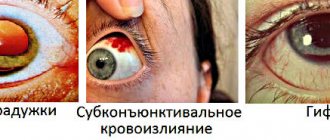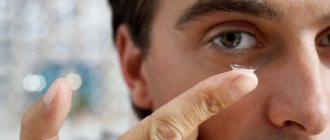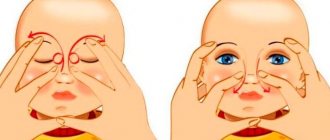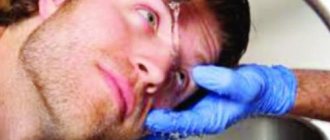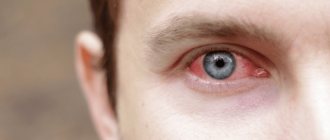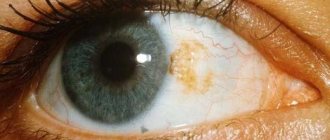Vision is one of the main sources of receiving information from the outside world. It is not surprising that the receptor part of the visual analyzer (the eye) is a rather sensitive organ. When foreign objects enter it, the following reactions immediately begin: lacrimation, a feeling of discomfort.
There is a desire to get this item yourself, often with untreated hands. If the object causing inconvenience is not located deep, then removal can be achieved without resorting to medical assistance.
It should be noted that the entry of foreign particles into the ocular structures is the most common circumstance in which patients seek emergency services from an ophthalmologist . Therefore, this problem is quite relevant.
Moreover, most often the problem arises in domestic conditions or during the work process. The article draws attention to the nature of foreign bodies, their impact on the visual analyzer and methods of safe removal.
Foreign object entering the eye
Any organic matter, for example, wood or copper and aluminum objects (for example, shavings) must be removed immediately, since the oxidation products of these materials will chemically react with the tissues of the eye structures within 24 hours. Blindness may occur as a complication.
Removing brick or coal is a rather difficult procedure even for a professional, since the material crumbles. A particular difficulty is caused by the volatile particles of the grinder. The flying hot particle of metal penetrates deeply into the eye structures and remains there. This foreign body also crumbles easily during the extraction procedure.
Therefore, below we will tell you how to remove scale from your eye.
How to remove scale from your eye?
Dust or eyelashes also very often get into the eye tissue. Foreign bodies can also be living: for example, midges and other small insects. But unlike hot bodies, such as scale, these objects are not fixed to the cornea. Therefore, their removal is comparatively easier.
Consequences
The eye becomes inflamed and swollen.
If you do not immediately remove the chips and allow them to remain in the eye for a long time, the risk of developing such dangerous ophthalmological complications as:
- post-traumatic keratitis;
- corneal ulcers;
- decreased visual function;
- infection and inflammation;
- loss of vision.
How to get dross out of your eye
The extraction procedure is performed in the ophthalmologist's office. First, the doctor carefully examines the eye, assesses the severity of damage to the organ of vision and the degree of visual impairment. The examination is carried out using a slit lamp.
Anesthetic drops are used to relieve pain and blepharospasm, a condition characterized by involuntary contraction of the eye muscles.
After determining the location of the scale, the doctor performs the following manipulations:
- Using an injection needle or a special tool - a chisel, the scale is removed.
- Then the size of the damage formed on the corneal epithelium is assessed.
- Afterwards, a cycloplegic drug is injected into the eye. Such medications are used in the diagnosis and treatment of various pathologies to immobilize the ciliary muscle.
- Next, the eye is treated with an ointment containing an antibiotic.
- After treatment, a sterile pressure bandage is applied. It must be worn for at least 24 hours.
If there are a large number of foreign bodies, they are removed by washing.
The doctor may leave the scale in the eye for a while so that it moves on its own to the surface of the cornea. This will facilitate the process of its removal and avoid severe damage to the eye tissue.
Why do you need to get it sooner?
If wood or metal shavings do not come out of the eye with rinsing, they should be removed by an experienced doctor using special tools.
Hurrying to remove the foreign body as soon as possible is necessary to prevent further mechanical damage to the eye. The fact is that due to irritation of the mucous membrane, the victim begins to blink quickly as a defensive reaction, and if the shavings stick to the inside of the eyelid, this will lead to even greater damage and injury to the eye.
If a person closes his eyelids too much, sawdust or metal scale can penetrate inside the cornea, then surgical removal of the object will be necessary. It is especially important to remove iron filings as soon as possible, as they quickly oxidize, causing rust to form. The oxide penetrates the inner layers of the sclera, causing inflammatory complications, pain, discomfort, and blurred vision.
What not to do
Sometimes, in the absence of the opportunity or desire to contact a doctor, victims try to get the scale on their own. This is strictly not recommended, since even extraction using special ophthalmic equipment can lead to even more severe damage to eye tissue. Independent intervention is fraught with serious damage, infection and the development of severe complications, including complete loss of vision. If an unpleasant incident occurs in the evening, on a weekend or a holiday, then you need to call the emergency room, whose employees will tell you the nearest locations of points operating around the clock. If necessary, emergency assistance will take the victim to one of these points.
To avoid damaging an already injured eye, you should never:
- Rub it with your hands.
- Blink frequently.
- Close your eyes with force.
Such actions can provoke the movement of scale into even deeper layers of the organ of vision and significant damage to its tissues.
You also cannot self-medicate using “proven” home remedies - honey solution, aloe juice, etc. Such remedies, although they have medicinal properties, are significantly less effective compared to pharmaceutical antiseptic drugs. The only thing that can be achieved by using home remedies is the introduction of infection and the development of complications.
What is prohibited?
During self-removal, you can injure your eye.
If chips get into your eyes, it is strictly contraindicated to perform the following actions:
- Rub your eyelids. Friction leads to even greater trauma to the mucous membrane and deeper penetration of scale into the soft tissue of the cornea.
- Remove the foreign body with sharp objects. Doctors practice removing foreign objects with special needles, but doing this yourself is strictly contraindicated, as you can harm yourself even more.
- Drop medications into the eyes at your discretion.
- Rinse the mucous membranes with substances that may cause additional irritation.
First aid for injury
Before emergency medical assistance arrives or you contact a specialist yourself, you must take the following actions:
- Rinse the eye under running clean, cool water for 15–20 minutes.
- Inject a few drops of an antiseptic solution into the organ of vision.
- Apply a cold compress to the affected organ of vision. To do this, you need to fold a small piece of sterile bandage several times, moisten it in clean cold water and apply it to the eyelid. This compress is secured with a bandage and adhesive tape.
After this, you need to urgently go to the doctor.
The bandage should hold the eye tightly in place to prevent any movement of the eyeball.
Scale can get on the surface of the cornea, causing a thermal burn, or penetrate into the deeper layers of the eye, cutting its tissue. In both cases, any movement of the diseased visual organ will cause severe pain.
What to do?
You can try to remove scale from your eyes yourself, at home. But before proceeding with the extraction procedure, it is necessary to determine where the foreign body is localized, since it is not fixed to the mucous membrane and can move from one place to another. Therefore, you must first stand in front of a mirror, provide good lighting and examine the upper and lower eyelids. When the location of the scale has been determined, gently grab the eyelashes with your fingers and move the eyelid forward. With your free hand, press the cotton swab parallel to the edge of the eyelid towards the middle. Next, you need to pull the eyelashes so that the eyelid turns out, then remove the shavings with a stick.
You can use a cotton swab as a tool.
If you can’t remove scale from your eye on your own, you can ask your neighbor for help. It is better for the victim to stand near the window so that the person providing assistance can clearly see and identify the foreign body. The algorithm of actions is the same as during self-help - the eyelids are pulled back behind the eyelashes, after the object has been found, the eyelid is turned inside out and the foreign object is removed using a cotton swab.
Another way to help get rid of chips in the eye is to rinse with water. To do this, it is recommended to use a pipette or a small enema. Boiled and cooled water is taken into the container, after which the eye is carefully washed. During rinsing, it is important to monitor the speck and the stream of water to help it move towards the inner edge of the eyelid. When the scale is in a convenient and safe place, you need to quickly remove it using a cotton swab.
What to do if a foreign object gets into your eye
We'll tell you what to do with scale that gets into your eye: how you can try to get it out, what you definitely shouldn't do, and how you can speed up the healing process.
Why is a metal foreign body dangerous?
If shavings from an angle grinder get into your eye, it means that the organ of vision is exposed to three negative effects at once:
1. Mechanical injury: flying off at speed, a foreign body violates the integrity of one or several layers of the eye. 2. Thermal burn: chips entering the eye are heated, which further damages the structures of the eye. 3. Chemical reaction of metal and intraocular fluid: when scale from a grinder gets into the eye, and it is in a saline solution of tear fluid, after a while rust appears around it, further impairing vision.
First aid algorithm
The first question is not how to get the scale out of the eye, but how to minimize the thermal burn. This can be done by rinsing the eye with cool water from a syringe, clean syringe or dropper. Water should be boiled or bottled; you can also use a sterile sodium chloride solution.
When rinsing, it is important not to create increased liquid pressure on the eye, but to direct the liquid in a weak stream - from the outer corner of the eye towards the nose. This is so that if the scale becomes fixed in the eye structures, you will not dislodge it with water.
Rinsing with a cool liquid not only cools the eye and reduces the depth of the burn. It also helps in how to get scale out of the eye if it is not fixed in the tissues.
What should you do if even after washing your eyes you still see shavings? Open your eye and look in the mirror, do the following:
• blink a little (without effort) and assess whether the foreign body moves; • if it changes its position, you can try to remove it; • if the scale does not mix on the surface of the eye, you should contact an ophthalmologist.
Let's talk about how to get metal shavings out of your eye if they move when you blink:
1. take a small piece of gauze, a clean handkerchief or a cotton swab; 2. Fold the handkerchief or gauze into a triangle to form a fairly rigid angle; 3. do not wet either the napkin or the cotton swab; 4. stand in front of the mirror; 5. open your eyes wide; 6. try to carefully pry up the shavings with the edge of a scarf, napkin or cotton swab; 7. remove the foreign body from the eye; 8. If it doesn’t work, repeat it all over again, first checking the mobility of the chips.
You can try to remove loose scale with a magnet. But after this, an examination by an ophthalmologist is also necessary.
How can you get the chips out of your eye if they are tightly fixed? To do this, you just need to contact an ophthalmologist. It is not recommended to use magnets or sharp objects at home. This can damage the deep structures of the eye, and they will heal with scarring or the formation of a cataract, which will lead to loss of vision.
How to go to the hospital with scale in your eye?
Actually, it's not very simple. If you don't follow the rules, you can harm yourself even more.
So, if there is fixed scale in the eye, what to do at home:
1. Close the affected eye, but do not squint it. 2. Place a gauze bandage or clean cloth over the eye. 3. Secure the bandage with a bandage - carefully so that the strips of the bandage do not put pressure on the eye. 4. Go to a hospital where there is an eye trauma department. During the daytime, you can go to the clinic at your place of residence or to a private ophthalmology clinic if operations are performed there. It’s not worth going to a private eye doctor who specializes in vision correction.
If a metal foreign body is not just fixed to the surface of the eye, but also caused damage to the eyelid (that is, it is a penetrating wound), the algorithm will be different:
1. Do not try to get a foreign body under any circumstances; 2. First cover the eye with gauze or a clean cloth, and place a dense object such as a deodorant cap on top; 3. glue the eye over the lid; 4. call an ambulance; 5. Cover the other, healthy eye with a gauze bandage (this is necessary so that the diseased eye does not move along with the healthy eye and is not damaged even more).
What not to do with scale and metal shavings
We found out what to do if chips get into your eye. Now let's list what you can't do:
• rub your eye; • squint; • try to get the scale out with a sharp object; • rinse the eye if the wound is through; • drip any drops before examination by an ophthalmologist; • use a magnet to remove fixed chips.
What to do after removing scale from the eye
After the foreign body has been removed on your own, go to an ophthalmologist - maybe even one who sees you in a private office. He will examine the eye under magnification (using a slit lamp) to make sure that the integrity of the deep structures is not damaged. After that, he will schedule the treatment. Before this, it is not recommended to use any drops or gels: they should not be allowed to get into the sclera or aqueous humor.
After the doctor is sure that the cornea has suffered minimal damage and other structures remain intact, he will prescribe the treatment. It usually includes antibiotics - in the form of drops or tablets.
Come for diagnostics at the address: Almaty, Tole bi street, 95a (corner of Baitursynov street).
Telephone; +7 (727) 279 54 36
Instagram eyeinst_kz
Website eyeinst.kz
When is medical help needed?
If you cannot remove scale from your eye yourself, you should not expect it to come out on its own, because prolonged exposure of a foreign object provokes dangerous consequences, leading to partial or complete loss of vision. The victim must be taken to a medical facility, where an ophthalmologist, after an initial examination, will remove the chips using special surgical instruments.
It is important to immediately contact the emergency room if a hot spark from an angle grinder or slag from welding gets into your eyes. In this case, you need to rinse the mucous membrane, which will help reduce pain and immediately go to the hospital, as the damage can be serious.
Severity of injury
When any foreign body gets into the eye, it is called mechanical damage. It also has its own degree of injury:
- 1st degree.
You do not feel anything foreign when you blink, your vision does not deteriorate. - 2nd degree.
There is slight discomfort and vision may deteriorate slightly. - 3rd degree.
Blindness in one eye. The visual reflex is completely absent.
This injury often affects the eyeball, as well as other parts of this organ. Do not ignore the symptoms, even the slightest discomfort, seek qualified help.
What treatment is prescribed?
If a bacterial infection is present, an antibiotic is prescribed.
After removing the scale, there is often discomfort and an unpleasant sensation of the presence of a foreign body in the eye, and the whites may appear inflamed. This is often a symptom of microtraumas that arose due to irritation of the mucous membrane by sharp shavings. To prevent infection and the development of bacterial complications, the doctor prescribes antibacterial drops, which should be taken 1 drop 3-4 times a day for 5-7 days. The following effective eye antibiotics in the form of drops are used for treatment:
- "Tobrex";
- "Gentagut";
- "Moxicin."
Eye ointments and gels are also prescribed, which promote rapid healing and restoration of the mucous membrane. To prevent dust and dirt from entering the injured organ, it is recommended to use a sterile gauze bandage during drug treatment. By following the advice and recommendations of the doctor during the rehabilitation period, it will be possible to prevent complications and speed up recovery.
Clinical picture
Metal bodies entering the eye tissue can result in mechanical injuries. Depending on the severity of the impact, the following types of damage are distinguished.
Getting scale into the eye after welding
TypeDescription
| Light form | No damage whatsoever. |
| Medium form | Minor defect visible with instruments and possible slight impairment of vision. |
| Severe form | Large defects leading to serious visual impairment, including blindness. |
Damage is localized in the following structures:
Foreign body in the eye
Symptoms:
If such a problem occurs, symptoms appear immediately
An ophthalmologist can accurately classify an injury using his or her instruments based on microscopic magnification of the site of the injury. After the extraction procedure, symptoms of damage may remain, especially for injuries that are deeper than the top layer of the cornea. Residual signs are associated with post-traumatic local edema.
Scale recovery methods
It is advisable to remove a foreign object from the eye with a needle no larger than 25 gauge (on the packaging of a disposable syringe there is a 25G mark - the larger the numerical value, the smaller the gauge).
You cannot remove a foreign object with untreated hands and especially with your tongue.
Removing scale with these objects can lead to the introduction of foreign particles deeper, and contact of eye tissue with the tongue is fraught with infection and an increased risk of the need for enucleation (removal of the eyeball).
Do not remove scale with dirty hands or improvised means.
In case of deep contact or artificial introduction of objects into the eyes, it is recommended to blink less often and rinse the eyes only with boiled water. You should not use remedies based on folk recipes and advice. Removal of scale and bodies of a different nature must be carried out by an ophthalmologist (if necessary, an ophthalmic surgeon). The procedure is performed by a specialist.
An ophthalmic surgeon operates
Survey
First of all, the doctor collects the patient's medical history. He asks about the details of the foreign particle entering the eye, how well the patient followed the rules for safe operation of the welding machine and for other activities.
This information is important for approximate determination of the presence and depth of the body. In addition, visual acuity is assessed.
The ophthalmologist instills a few drops of anesthetic to relieve pain and blepharospasm (involuntary contraction of the orbicularis oculi muscle, which manifests itself in the closing of the eyes), the doctor evaluates the location using microscopic analysis.
The presence of infiltrates is assessed and the immunological reaction occurring in the anterior chamber, which is limited by the cornea and iris, is monitored. Next, the pupil is dilated with medication. This is necessary for examining the retina.
Your doctor may order an exam to determine how severely the eye is affected.
If there is a risk of serious damage to the eye due to an ingested foreign body, there is a need for additional instrumental studies. For example, radiography of the orbit. In complicated situations, in addition to the ophthalmologist, a neurologist and an otorhinolaryngologist are included in the treatment.
X-ray of the orbit
Scale that gets into the eyes will instantly cause a burn, since it is a spark - a hot metal body that is tightly fixed and cools right on the surface of the eye. It is almost impossible to get it on your own.
After the removal is carried out, the consequences of the burn must be treated by a professional. The patient must unquestioningly follow the doctor's recommendations.
The ophthalmologist prescribes antibiotics and NSAIDs, both in the form of ointments and drops, and in forms for oral administration.
Vision may be impaired if scale gets into the central cornea. Then the recovery will last longer than usual (rehabilitation on average takes from a week to two weeks).
Usually scale gets into the eye while working with a welding machine or grinder without glasses.
Extraction technique
The following technique is used by a professional ophthalmologist. Execution of this algorithm requires appropriate equipment and professionalism. First, the specialist cleans his hands with soap and a 70% alcohol solution; instills a 2% lidocaine solution, having first taken the solution with a disposable sterile syringe and disconnected the needle.
The sterile needle is held with three fingers at the connecting part of the needle with the syringe. The dominant hand with the needle is fixed with the edge of the palm on the patient’s cheekbone or cheek (necessary to prevent injuries due to involuntary movements). The eyelid is pulled back with the left hand.
The doctor asks the patient to look at one point, which is selected so that the position of the eyeball facilitates access to the foreign body. The light is directed into the eye and the procedure is controlled with a magnifying glass. The tip of the needle is used to remove the foreign object and clean the wound. If necessary, the doctor will instill an additional dose of lidocaine.
After removal, antibiotics are applied topically (in the form of drops or ointments). 1% tetracycline ointment can be used. The doctor prescribes medications for outpatient use.
Only a doctor knows exactly what actions to take in a particular case
If it is impossible to quickly obtain recommendations from an ophthalmologist, then you should provide competent first aid and remove the object yourself. Then the extraction technique is as follows.
- Wash your hands thoroughly.
- Rinse your eyes with clean water, preferably boiled.
- Determine the location of a foreign object. Go to the mirror and sequentially pull down the lower and upper eyelids. If the object is not deep in the lower eyelid, then you can remove it using the tip of a clean scarf or a cotton swab.
- If the body gets into the upper eyelid, the extraction procedure requires special care; intense pain is possible.
You can try to pull your eyelashes so that the object falls out on its own. If the discomfort remains and the object is not removed, try to remove the body with a sponge or cotton swab. Removing a Foreign Object - If the scale is not fixed on the eye, which is extremely rare, then you can try to blink, after first lowering your face into a container with boiled (but cooled!) water.
- Using a magnet is effective.
It is necessary to hold the magnet at a close distance to the open and unfolded eyelid. If the foreign particle is not visible in the mirror, but the feeling of discomfort remains, then the eye must be dripped with an antiseptic, because, most likely, the body scratched the cornea during removal. You can try using a magnet - Containing tannins (aromatic substances that give the drink a tart taste and have astringent properties, due to which the mechanical barrier of the outer integument becomes stronger) substances, tea can be used as the basis of a gauze compress if the eyes are rubbed during the extraction process. The compress should be secured with a bandage or plaster.
Types and symptoms of traumatic eye injury
An unpleasant case where metal shavings get into the eye is considered mechanical damage. Depending on the severity, the following types of eye injuries are distinguished:
Mild degree - does not threaten cosmetic defects or loss of vision. Moderate injury - slight cosmetic defect, slight decrease in vision. Severe degree - significant deterioration of vision or its complete loss as a result of the appearance of defects in the structure of the eye.
The location of the traumatic injury may be as follows:
damage to the eyeball; eye sockets; accessory parts of the eye.
Main symptoms of damage:
involuntary closing of the eyelids, it becomes difficult to open them independently; redness of the eye; pain in the eye area; secretion of tears; blurred vision.
These are the main signs of damage, but they do not make it possible to determine with high accuracy how badly the eye is damaged. The extent of damage can only be determined by an ophthalmologist using a microscope.
After removing the shavings from the grinder, the same symptoms may be observed, with the exception of severe lacrimation . Especially if the damage is deeper than the top layer of the corneal epithelium.
This occurs due to post-traumatic swelling. Therefore, even after correctly provided first aid, it is better to see a doctor .

